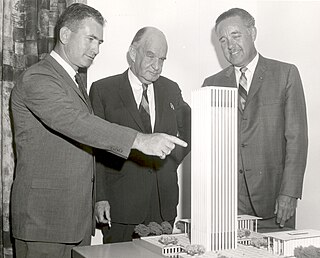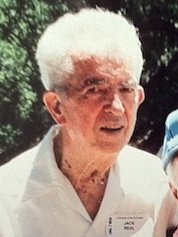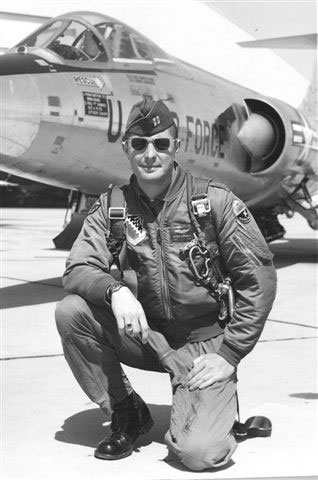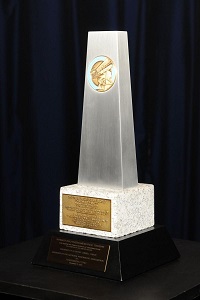Related Research Articles

Howard Robard Hughes Jr. was an American aerospace engineer, business magnate, film producer, investor, philanthropist and aircraft pilot. He was best known during his lifetime as one of the richest and most influential people in the world. He first became prominent as a film producer, and then as an important figure in the aviation industry. Later in life, he became known for his eccentric behavior and reclusive lifestyle—oddities that were caused in part by his worsening obsessive-compulsive disorder (OCD), chronic pain from a near-fatal plane crash, and increasing deafness.

Edward Durell Stone was an American architect known for the formal, highly decorative buildings he designed in the 1950s and 1960s. His works include the Museum of Modern Art, in New York City; the Museo de Arte de Ponce in Ponce, Puerto Rico; the United States Embassy in New Delhi, India; The Keller Center at the University of Chicago; the John F. Kennedy Center for the Performing Arts in Washington, D.C.; and the EcoTarium, formerly known as the New England Science Center in Worcester, Massachusetts.

The Robert J. Collier Trophy is awarded annually for the greatest achievement in aeronautics or astronautics in America, with respect to improving the performance, efficiency, and safety of air or space vehicles, the value of which has been thoroughly demonstrated by actual use during the preceding year.

Richard Glenn Rutan was an American military aviator and officer, as well as a record-breaking test pilot who in 1986 piloted the Voyager aircraft on the first non-stop, non-refueled around-the-world flight with co-pilot Jeana Yeager. He was the older brother of famed aerospace designer Burt Rutan, whose many earlier original designs Dick piloted on class record-breaking flights, including Voyager.

The Aviator is a 2004 American epic biographical drama film directed by Martin Scorsese and written by John Logan. It stars Leonardo DiCaprio as Howard Hughes, Cate Blanchett as Katharine Hepburn, and Kate Beckinsale as Ava Gardner. The supporting cast features Ian Holm, John C. Reilly, Alec Baldwin, Jude Law, Gwen Stefani, Kelli Garner, Matt Ross, Willem Dafoe, Alan Alda, and Edward Herrmann.

John Leland Atwood was a prominent American engineer. He worked as Chief Engineer/Executive at North American Aviation for over 35 years, succeeding Dutch Kindelberger as president and CEO. He developed the P-51 Mustang during World War II, the F-100 jet fighter, the X-15 rocket plane, and oversaw the Apollo program.

Franklin Davis Robinson was an American aeronautical engineer and the founder of Robinson Helicopter Company in Torrance, California. He served as president, chief executive officer, and chairman of the company for many years. In the early 1970s, Robinson designed the Robinson R22 helicopter, a popular, light, two-place civilian aircraft, which later developed into the R44, one of the most successful civilian helicopters in history.

The Texas State Cemetery (TSC) is a cemetery located on about 22 acres (8.9 ha) just east of downtown Austin, the capital of the U.S. state of Texas. Originally the burial place of Edward Burleson, Texas Revolutionary general and vice-president of the Republic of Texas, it was expanded into a Confederate cemetery during the Civil War. Later it was expanded again to include the graves and cenotaphs of prominent Texans and their spouses.

The National Aviation Hall of Fame (NAHF) is a museum, annual awards ceremony and learning and research center that was founded in 1962 as an Ohio non-profit corporation in Dayton, Ohio, United States, known as the "Birthplace of Aviation" with its connection to the Wright brothers. In 2017, the annual induction was held in Fort Worth, Texas, as the organization began rotating the ceremony among various cities.
The Scripps Howard Awards, formerly the National Journalism Awards, are $10,000 awards in American journalism given by the Scripps Howard Foundation. Awardees receive "cash prizes, citations and plaques."
Allen Eugene Paulson was an American businessman.
Moye Wicks Stephens was an American aviator and businessman. He was a pioneer in aviation, circumnavigating the globe with adventure writer Richard Halliburton in 1931, and co-founding Northrop Aircraft, Inc.

Jack G. Real was an aerospace pioneer and Howard Hughes confidant.

Edward Carroll Stone was an American space scientist, professor of physics at the California Institute of Technology, and director of the NASA Jet Propulsion Laboratory (JPL).

George J. Marrett is a former United States Air Force officer, combat veteran, and test pilot. He is the author of many aviation-related books and articles.

The Wright Brothers Memorial Trophy was established by the National Aeronautic Association (NAA) in 1948 after a trust fund was created in 1936 by Godfrey Lowell Cabot of Boston, a former president of the NAA. It is awarded to a living American for "significant public service of enduring value to aviation in the United States." The presentation of the award is made annually at the Aero Club of Washington, as close as possible to December 17 each year, the day on which, in 1903, the Wright brothers made the first flight in an airplane. The inaugural recipient of the trophy was William F. Durand, "a pioneer in aeronautics, naval propulsion and engineering research methods". Until 2010, winners of the award received a trophy depicting the Wright brothers' Wright Flyer aircraft. From 2010 onwards, a redesigned trophy featuring a silver obelisk and bronze inscription has been awarded.

Hershel Clay Lacy is the founder and former CEO of Clay Lacy Aviation, established in 1968 as the first executive jet charter company in the Western United States.
Robert F. Kennedy Human Rights is an American 501(c)(3) nonprofit human rights advocacy organization. It was named after United States Senator Robert F. Kennedy in 1968, a few months after his assassination. The organization of leading attorneys, advocates, entrepreneurs and writers is dedicated to a more just and peaceful world, working alongside local activists to ensure lasting positive change in governments and corporations. It also promotes human rights advocacy through its RFK Human Rights Award, and supports investigative journalists and authors through the RFK Book and Journalism Awards. It is based in New York and Washington, D.C. Robert F. Kennedy's daughter, Kerry Kennedy, serves as the organization's President.
The Living Legends of Aviation is an organization of remarkable people of extraordinary accomplishment in aviation and aerospace including: entrepreneurs, innovators, industry leaders, engineers, astronauts, record breakers, pilots who have become celebrities and celebrities who have become pilots. The Living Legends meet yearly in North America at The Beverly Hilton and in Europe every-other-year at the Scalaria Resort at a 15th century castle on the Wolfgangsee near Salzburg, Austria. Inductees and Awards are selected by the Living Legends of Aviation and by committees within the organization. These most prestigious awards are produced by and benefit the Kiddie Hawk Air Academy, a non-profit 501(c)(3).
References
- ↑ "Edward C. Stone, 1936-2024". News. CalTech. June 11, 2024. Retrieved 2024-11-22.